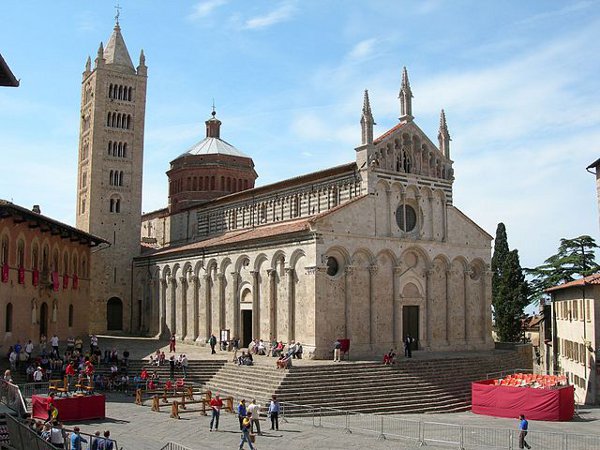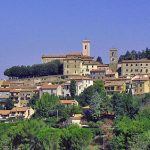Massa Marittima is one of the major tourist destinations of Tuscany and the city it is located in an area of exceptional beauty and interest to the Metalliferous Hills.
Immersed in the Tuscan Maremma, 20 km from the sea, Massa Marittima, cultural center of the “Metalliferous Hills”, is located at an altitude of 380 meters. The municipality covers an area of 284 km2 and has a population of about 8800 inhabitants, who lives in an area of great natural beauty, with copses, maquis, fields dedicated to agriculture and grazing.
The Etruscans were the first to exploit the mining area and around 750 BC the extraction of minerals brought this people to be the richest in central Italy. The city of Populonia and Vetulonia drove the dominions to the Metalliferous Hills. Populonia drew wealth from the iron ore extracted from the fourth century BC, the island of Elba, from Vetulonia, however, left many of the locals to go and settle in the villages around the present Massa Marittima (so that, in the vicinity of the lake dell’Accesa, were found traces of this presence). In these lands were abundant mineral-rich silver and copper. And the discoveries made are evidence of continuity in the treatment of minerals, which is not much different from that of modern steel mills and foundries, have been found, in fact, remains of furnaces, and increasingly around the lake dell’Accesa, the foundations of a settlement the sixth century BC where they lived probably the leaders of a mine. The Etruscans transformed those minerals rich in gold, iron, silver, lead, copper, jewelry and objects of various use.
The excavations, conducted periodically since 1980, have brought to light, on the high south-east of the lake, many living quarters, which are only visible foundations of the buildings.
These nuclei comprising about ten houses each, usually two or three rooms. The construction technique was typical of Etruscan settlements: foundations of connected stones dry and raised brick raw or made with the technique of the trellis (wood poles, straw and clay); roof with roofing tiles, floor compact clay. In the village were found traces of activities related to the extraction and processing minerals, represented mainly by smelting slag.
The settlement, which has lasted for about a century (end of VII – beginning of the sixth century. BCE until the end of VI), depended on Vetulonia. Its end must be put in connection with the loss of control over mining areas by Vetulonia in favor of other centers, in particular of Populonia.
After the Etruscans, the Romans continued exploitation although to a lesser extent. With the barbarian invasions and the destruction of numerous villages, there was the abandonment of mines until the Middle Ages. The barbarian raids and those of pirates and Saracens down on their knees Populonia, whose diocese was transferred around the eleventh century, Massa.
The activity was resumed by the arrival of the Lombard masters, particularly comacini, labor Tyrolean Saxon and South Tyrol. Not surprisingly, Montieri, dominated by the Bishop of Volterra, in this period saw the increasing importance of own mines and Siena bought a part of the Silver Collection Montieri to mint coins. The extraction of minerals copper, zinc, lead and silver in particular, was therefore a significant boost in the medieval period.
The heyday as a mining center of Massa Marittima occurred between 1200 and 1350, for its heritage, in fact, was called “Mass Metallorum” (the city of metals). In 1225, the city became a free city, redeeming, by virtue of the wealth that came from its mines, the rule of the bishops and more than a hundred years he was able to maintain its independence.
It had its own mint, their weights and measures, and gave Europe the first Mining Code of the story: “Ordinamenta SUPER ART FOSSARUM RAMERIAE ARGENTERIAE CIVITAS Massai” (XIII century), wonderful example of legislation that regulated the exploitation of mining camps, witness the very high degree of development reached by the country both in terms of legal capacity in the management of subsoil resources.
From the middle of the fourteenth century. wars, plagues, subjection to Siena for four centuries put an end to mining in Maremma, the Republic of Siena and later the Medici, when they take the place of power, considered the region as a colony and reduced it to a state of extreme degradation.
Only since about 1830 the area entered a recovery phase, mainly due to the extensive reforms and remediation action undertaken by Lorraine. It was the Grand Duke Leopold II, who released the concessions for the first attempts to study mining in the area: these resulted in failures because the adverse environmental conditions, still plagued by malaria, never allowed to achieve concrete results even after fruitful research. Starting from 1860 a company was finally born, the “Phoenix Massetana”, which exploited profitably in the veins of pyrite in the lake area Accesa.
At the end of the century appeared in the Maremma “Montecatini Company” (which took its name from its first mine, located in Montecatini Val di Cecina, in the province of Pisa), which in a short time acquired the majority of the mines of the district and it increased the production boosting, over the years, to a chemical that used the first product from the processing of pyrite: sulfuric acid.
The rest is recent history: the mines were for decades the backbone of the local economy, which was based almost entirely on the mining and processing activities on the side of the sulphides, and this sector has undergone a period of serious decline, the mines were all closed and Massa Marittima is trying to revive its economy with tourism.
Visiting the city meet the monuments and buildings of extreme particularity, such as the Cathedral of San Cerbone, which was built in 1200 in Romanesque style, today houses a number of important works of art, like a stained glass window made in 1300 representing the Redeemer in Glory and Stories San Cerbone, also a fresco dating back to the fourteenth century and depicting the Madonna and Child Enthroned, frescoes which have as their subject the Crucifixion, the Madonna in Glory with Saints Joseph and Bernard with two monks, attributed to Nasini, San Cerbone with Geese; inside the Cathedral are also a baptismal font, some columns topped by figures of a Griffon, a man with a beard and a horse, a wooden Crucifix by Giovanni Pisano and finally as many as 11 small statues depicting saints and prophets, who along with some frescoes are found in the crypt.
On the square in front of the cathedral are also the Praetorian Palace, built in the thirteenth century, the Palace of the Counts Biserno and the Medieval Palace of the City, one of the main peculiarities of the Tuscan city is to be divided into two parts: the oldest part, surrounded by walls is the Old Town, within which we find the House of San Bernardino and the Palazzina della Zecca, old building where the coins were minted, while, outside the walls meet the Church of San Francesco, in style Gothic, the Church of St. Augustine, the Church of San Rocco, built around 1400, and finally the Renaissance Palace of Arms, which are instead the New Town.
Many museums have been set up in Massa Marittima: the Archaeological Museum, the Mining Museum, the Museum of Art and History of the Mine, the Archaeological Park of Lake dell’Accesa, the Old Mill and Old Joinery.
The origins of the city are to be placed in the Middle Ages, it was built in the territory of Mount Royal and around Mille assumed considerable importance and became a bishopric; Massa Marittima later became the Free City, but it was still conquered and controlled by Pisa, Siena and Florence, under the dominion of which became part of the possessions of the Grand Duchy of Tuscany.
Another element of pride for the city is definitely the award of the Medal of Military Valour, for the courage and the activity of the population in the years of the Second World War.
The city is also famous for its wine DOC, the Monteregio of Massa Marittima, consisting for the most part on the type of Sangiovese and Trebbiano Toscano red for white; famous desserts are also being produced in Massa Marittima, as Panforte, the Seahorses and Ricciarelli.
Quick guide for the search of its solutions for holidays in Cecina.
Those who approach the idea of spending his holidays in Massa Marittima will need to consult a guide to find hotels in Massa Marittima Massa Marittima Hotels or hotels Cecina.
For those in search of the substance and a room can be enough rooms or rooms holiday accommodation Tuscany Coast Tuscany or even rooms for rent Tuscany should be appropriate search terms as well as rooms Massa Marittima.
The Italianists prefer to look for hotels or hotels on the Tuscan coast in Tuscany.
Should nonetheless be acknowledged that Massa Marittima is located on the Etruscan Coast, which is in fact in Tuscany sea, and the Coast Tuscany is unique in the world.
Given that in recent years tourism has largely shown a preference for solutions besides housing type hotel, residences Massa Marittima Massa Marittima holiday apartments, holiday apartments in the Tuscan coastline, have become frequent rumors of research on texts on the Tuscan coast tourism guide .
It is also for this second chapter as previously said about the Etruscan Coast, then in reading pamphlets on Massa Marittima or even where to sleep only to be sought in Tuscany or type the entries residence Massa Marittima Massa Marittima apartments, hotels or even Cecina hotels Massa Marittima.
Then refer to the Help in the Tuscan coast hotels will be well oriented to the voice holidays Tuscan coast and search for hotels in the fen or, if you prefer, hotels Tuscany Coast.
The search for residence on the Tuscan Coast could be profitable since the topic is more general summer holiday in Tuscany, apartments for rent, seaside tuscany, holidays on the sea.
It is not to be neglected even the search for rooms Massa Marittima, in the end we are talking about Tuscany Italy, holiday apartment Tuscany, someone with more economic means seeking Villa Massa Marittima or even Tuscan coast villa rentals Massa Marittima.
For those who opted for a specific area such as the Etruscan Coast Cecina or in a particular way, it will be well to remember that the search terms to be extended in Massa Marittima studios besides vacation rental Tuscany Tuscany or even sea or cottages Massa Marittima.
Finally, not least, we must remember ‘s Farm or Tuscany Farmhouses Tuscany.
So let’s look at farm Massa Marittima.
Then there is the chapter of the holiday apartment very popular among couples and even by couples with a baby. Studios for rent Tuscany is therefore a search term very profitable, as well as studio apartments or houses Tuscany Massa Marittima.
https://tuscanysea.com/backoffice/immagini/tuscanysea.com/25-17-5-2013-11-30-321.jpg



